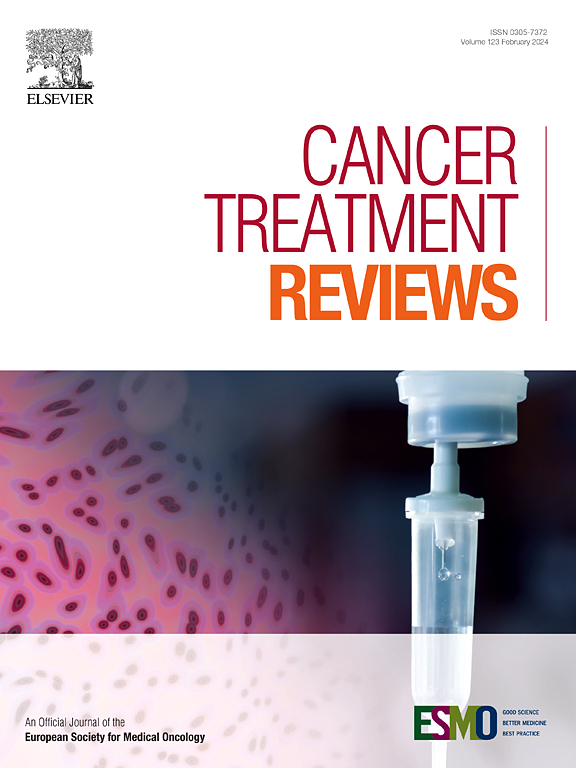肝细胞癌中微量残留病变的循环血液生物标志物:一项系统综述
IF 9.6
1区 医学
Q1 ONCOLOGY
引用次数: 0
摘要
根治治疗后复发仍然是肝细胞癌(HCC)的主要问题,5年内50 - 75%的早期病例复发。早期复发预测是临床尚未满足的需求。循环血液生物标志物可以提供一种微创方法来检测干预后的最小残留病(MRD)。虽然甲胎蛋白是这种情况下的主要生物标志物,但其MRD敏感性限制在50 - 70%。本系统综述的目的是总结现有的证据,这些证据与新出现的循环血液生物标志物在HCC患者MRD检测中的临床有效性和潜在效用有关。方法:我们检索PubMed和Embase,检索2025年之前发表的同行评议文章和摘要,检索ClinicalTrials.gov,检索正在进行的关于HCC中MRD的循环血液生物标志物的试验。结果共检索到91项研究(2386项研究中74项已获得结果,17项正在进行中)。我们评估了各种血液生物标志物,包括循环DNA (cDNA, N = 24),循环肿瘤细胞(ctc, N = 20),循环RNA (cRNA, N = 8)和其他杂项(N = 22)用于HCC的MRD检测。这些生物标志物显示出令人鼓舞的结果,尽管存在显著的异质性。特别是,循环肿瘤DNA (ctDNA)和ctc是最可靠的新方法,灵敏度为50 - 80%,特异性高达94%。尽管如此,17项正在进行的研究中没有一项涉及生物标志物驱动的干预来证明临床效用。结论新的循环血液生物标志物用于HCC的MRD检测已经成熟。然而,方法和结果的可变性突出了进一步验证的必要性。我们鼓励在介入性试验中研究CTCs和/或ctDNA,以评估临床效用。这种生物标志物驱动的方法可以提高mrd阳性病例的辅助治疗效果,同时最小化mrd阴性患者的毒性。本文章由计算机程序翻译,如有差异,请以英文原文为准。
Circulating blood biomarkers for minimal residual disease in hepatocellular carcinoma: A systematic review
Background
Relapse after radical treatment remains a major concern in hepatocellular carcinoma (HCC), affecting 50–75 % of early-stage cases within 5 years. Early recurrence prediction is a clinical unmet need. Circulating blood biomarkers could provide a minimally invasive approach to detect minimal residual disease (MRD) post-intervention. Although alpha-fetoprotein has been the primary biomarker in this setting, its MRD sensitivity is limited to 50–70 %. This systematic review aims to summarize available evidence regarding the clinical validity and potential utility of emerging circulating blood biomarkers for MRD detection in HCC patients.
Methods
We searched PubMed and Embase for peer-reviewed articles and abstracts published up to 2025, and ClinicalTrials.gov for ongoing trials on circulating blood biomarkers for MRD in HCC.
Results
A total of 91 studies (74 with results and 17 ongoing, out of 2,386) were retrieved. We evaluated various blood biomarkers, including circulating DNA (cDNA, N = 24), circulating tumor cells (CTCs, N = 20), circulating RNA (cRNA, N = 8), and other miscellaneous (N = 22) for MRD detection in HCC. These biomarkers demonstrated encouraging results, albeit with notable heterogeneity. In particular, circulating tumor DNA (ctDNA) and CTCs stand as the most robust novel approaches, with 50–80 % sensitivity and specificity up to 94 %. Nonetheless, none of the 17 ongoing studies involve biomarker-driven intervention to prove clinical utility.
Conclusions
Novel circulating blood biomarkers are mature for MRD detection in HCC. However, variability in methodologies and results highlights the need for further validation. We encourage the investigation of CTCs and/or ctDNA in interventional trials to assess clinical utility. This biomarker-driven approach may enhance adjuvant treatment effectiveness in MRD-positive cases while minimizing toxicity in MRD-negative patients.
求助全文
通过发布文献求助,成功后即可免费获取论文全文。
去求助
来源期刊

Cancer treatment reviews
医学-肿瘤学
CiteScore
21.40
自引率
0.80%
发文量
109
审稿时长
13 days
期刊介绍:
Cancer Treatment Reviews
Journal Overview:
International journal focused on developments in cancer treatment research
Publishes state-of-the-art, authoritative reviews to keep clinicians and researchers informed
Regular Sections in Each Issue:
Comments on Controversy
Tumor Reviews
Anti-tumor Treatments
New Drugs
Complications of Treatment
General and Supportive Care
Laboratory/Clinic Interface
Submission and Editorial System:
Online submission and editorial system for Cancer Treatment Reviews
 求助内容:
求助内容: 应助结果提醒方式:
应助结果提醒方式:


